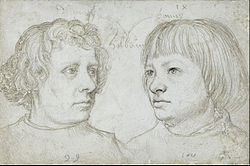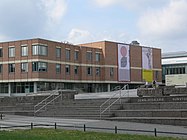Fil:Holbein portrait.png

Storleik på førehandsvising: 800 × 527 pikslar. Andre oppløysingar: 320 × 211 pikslar | 640 × 421 pikslar | 1 030 × 678 pikslar.
Opphavleg fil (1 030 × 678 pikslar, filstorleik: 1,22 MB, MIME-type: image/png)

Følgjande er henta frå filomtalen åt denne fila på Wikimedia Commons:
Filhistorikk
Klikk på dato/klokkeslett for å sjå fila slik ho var på det tidspunktet.
| Dato/klokkeslett | Miniatyrbilete | Oppløysing | Brukar | Kommentar | |
|---|---|---|---|---|---|
| gjeldande | 15. juni 2006 kl. 17:59 |  | 1 030 × 678 (1,22 MB) | Carlbaratta | Ambrosius and Hans Holbein 1511 Silverpoint on white-coated paper, 10.3 x 15.5 cm Kupferstichkabinett, Staatliche Museen, Berlin Metal Point In medieval times, metal point was used as the primary permanent mark-making tool for both artists and scribes. |
Filbruk
Den følgjande sida bruker denne fila:
Global filbruk
Desse andre wikiane nyttar fila:
- Bruk på arz.wikipedia.org
- Bruk på be.wikipedia.org
- Bruk på ca.wikipedia.org
- Bruk på cs.wikipedia.org
- Bruk på el.wikipedia.org
- Bruk på en.wikipedia.org
- Bruk på es.wikipedia.org
- Bruk på fi.wikipedia.org
- Bruk på fy.wikipedia.org
- Bruk på it.wikipedia.org
- Bruk på no.wikipedia.org
- Bruk på pl.wikipedia.org
- Bruk på pt.wikipedia.org
- Bruk på ru.wikipedia.org
- Bruk på sh.wikipedia.org
- Bruk på sr.wikipedia.org
- Bruk på www.wikidata.org


